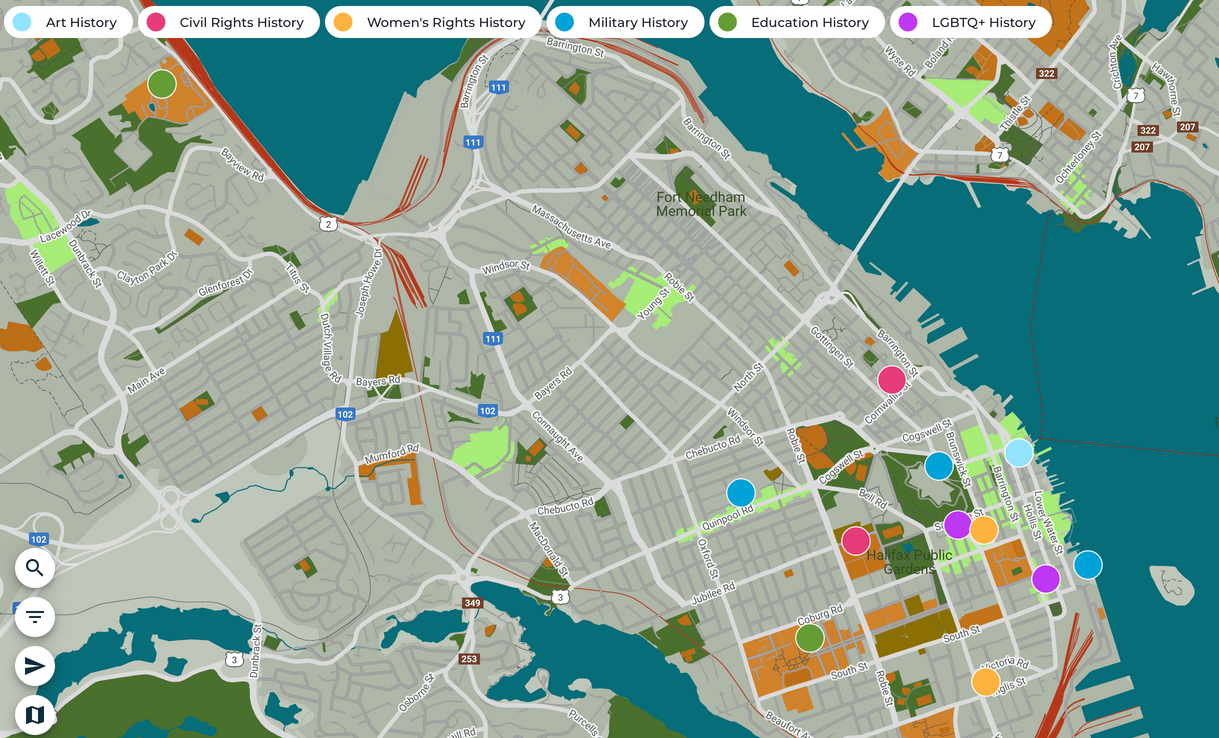Walking with women in history: Halifax Women's History tour
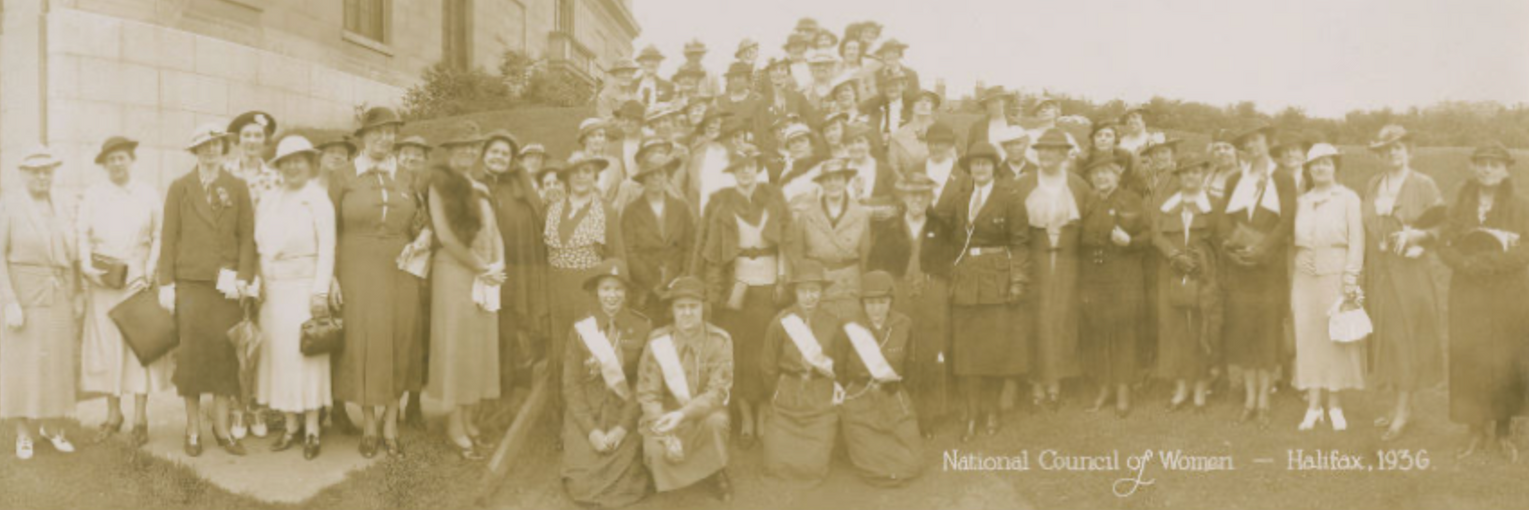
National Council of Women, Halifax (1936) as captioned by https://archives.novascotia.ca/eastcoastport/archives/?ID=33
About the Project
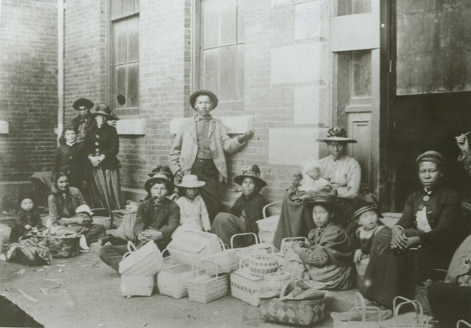
Selling baskets on market day, Halifax (1890) as captioned by https://archives.novascotia.ca/africanns/archives/?ID=148
This project was made for the Heritage Studies Capstone Course (HIST4710) at Dalhousie University, led by Dr. Jerry Bannister, as the final project. While reading Restoring Women's History Through Historic Preservation edited by Gail Lee DuBrow and Jennifer B. Goodman, the intro pointed to how small efforts can be made to improve the representation of Women's History, one suggestion was through the creation of a walking History tour. Despite spending the last four years in Halifax, and dedicating my studies to Women's History, I knew very little about the history right here in Halifax. For that reason, I decided to make a walking tour to showcase important events and women of Halifax who have made an impact over the past two hundred years. Additionally, it is important to note the Women of Nova Scotia History Tour (https://historicnovascotia.ca/tours/show/3), a tour made in conjunction with people across the province, which helped to inspire my tour.
Historic Landmark and Addresses
Click on map to be taken access it
Suggested route
Viola Desmond GraveSite
Viola Desmond grave site, South End, NS
Dr. MAria Louisa angwin Approximate first office
5431 Spring Garden Rd Unit 201, Halifax, NS B3J 1G4
Dresden arms hotel
5530 Artillery Place, Halifax, NS, Canada
The Halifax Citadel ($)
5425 Sackville St, Halifax, NS B3J 3Y3
Cornwallis St baptist church
5457 Cornwallis St, Halifax, NS B3K 1B1
MAUD lewis EXHIBIT - art gallery of ns ($)
1723 Hollis St, Halifax, NS B3J 1V9
The Statue of women volunteers
The statue of the women volunteers, South End, NS B3H 4P8
Forrest House
1225 Barrington Street, Halifax, NS, Canada
https://map.proxi.co/#command-center?topic_id=643d5738d80d95d3514effee&topic_key=Sy482CZgN8C4nK2y7WO8URvyI4kuYV
The Local Council of Women
989 Young Avenue, Halifax, NS
Estimated time for full tour
Walk - 2 1/2 hours
bike - 1 hour 15 minutes
drive - 1 hour
Additional Stop
Killam Memorial library
6225 University Ave, Halifax, NS B3H 4R2
Mount saint vincent university
145 College Rd, Halifax, NS B3M 2J6, Canada
Quinpool Road hostel
6219 Quinpool Rd, Halifax, NS B3L 4P6
Adds 1 hour for walking
Adds 25 minutes if biking
Adds 10 minutes if driving
Or create your own route!
Note, as google maps can only have ten addresses at a time, the last destination (Quinpool Road Hostel) will need to be addedd manually once you arrive at the Killam Library
Viola Desmond Gravesite
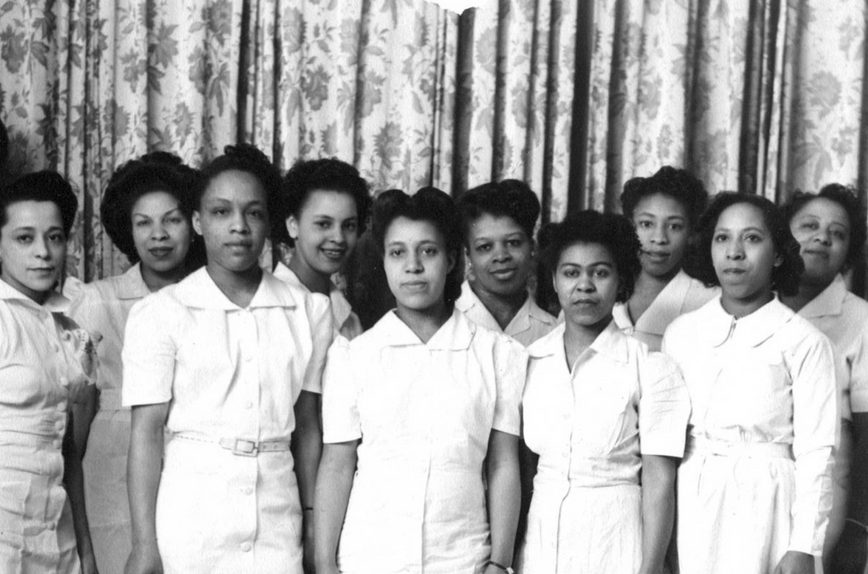
Viola Desmond was born in Halifax, NS in 1914 with big ambitions of owning her own beauty salon in the city. At the time NS beauty schools would not admit black students so Viola traveled to Montreal and the United States in order to get the education she needed. She returned to Halifax and opened her own Salon and beauty school, becoming a successful entrepreneur.

Viola Desmond with the 1947 graduating class from the Desmond School of Beauty Culture. Photo: Courtesy of Joe and Wanda Robson as captioned by https://humanrights.ca/story/one-womans-resistance

Viola Desmond Grave Site - Halifax, Nova Scotia as captioned by https://commons.wikimedia.org/wiki/File:Viola_Desmond_Grave_Site_-_Halifax,_Nova_Scotia_%2844403974182%29.jpg
For more stops on Viola Desmond check out the recent art instillation entitled The Viola Desmond Experience (shown below) located at 2300 Gottingen Street
(Inside one of Viola's Salons) as captioned by https://sites.google.com/a/churchillschool.com/viola-desmond-original/biography-1
In November of 1946, Viola decided to see a film at the segregated (unbeknownst to her) Roseland Theatre in New Glasgow, Nova Scotia. While there she was told to move from the main floor up to the balcony where people of color had to sit. Viola refused and was eventually dragged from the building and arrested.
Rather than accept the injustice of segregation in Canada, Viola took her case to the Supreme Court. Despite losing the case, her bravery to speak out sparked future generations to continue the fight against racism within Canada.
Sadly, after the case, Viola Desmond left her business and moved to Montreal. In 1965 she passed away in New York. In 2010 the Lieutenant Governor of Nova Scotia pardoned her case. In 2018 she became the first regularly circulated woman on the Canadian ten-dollar bill. Today, her grave is located in the Camp Hill Cemetery in Halifax where people can travel to pay their respects to a Canadian civil rights pioneer.
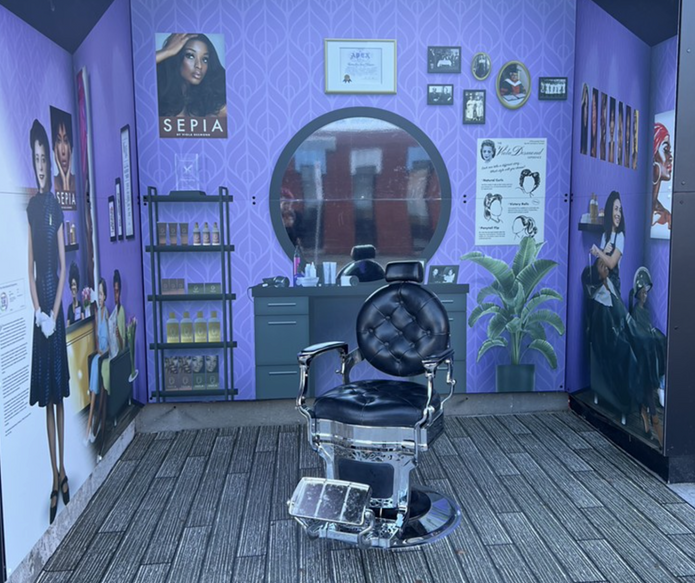
https://www.thecoast.ca/arts-music/new-viola-desmond-memorial-on-gottingen-street-celebrates-her-legacy-perfectly-29782659
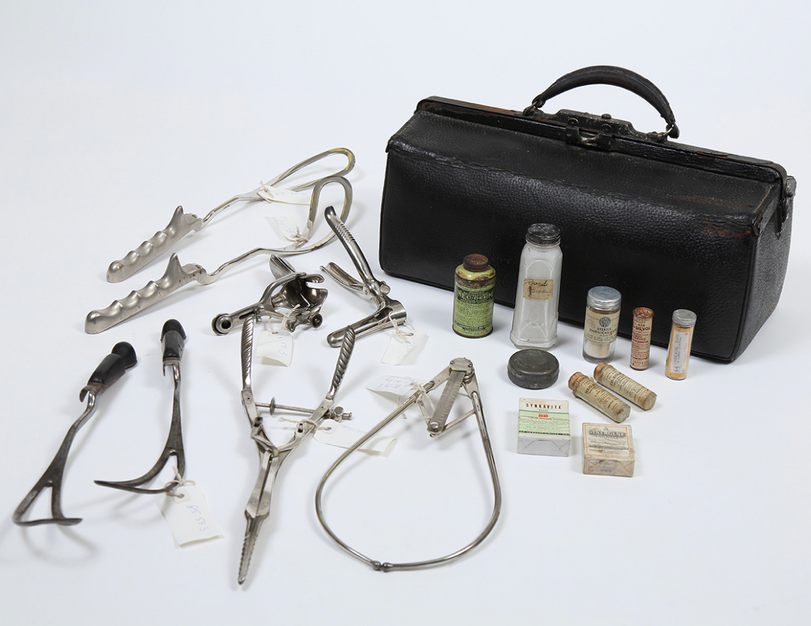
https://museum.novascotia.ca/collections-research/vanguard/gallery/objects/maria-louisa-angwin-1849-1898?position=28&list=_pCzwO3lUOzlt-487YQGT8ZvLB46F1MIen6hxcljgS0
Dr. Maria Louisa Angwin First Office
Maria Louisa Angwin, born in Newfoundland, moved with her family to Halifax in 1865 when she was still a child. As she grew, she eventually attended the provincial Normal College in Truro where she graduated with a teaching degree. Maria taught for five years, saving every cent she could, for she knew she would need it to accomplish her dream of becoming a medical doctor.
Maria, not one to give up on her dream, eventually made it to the United States and graduated from the Women’s Medical College in 1882. She spent the next few years in the U.S. and London honing her abilities in the medical profession before returning to Nova Scotia. Her return in 1884 caused her to become the first female licensed medical professional in the province.
Even to this day, Dr. Maria Louisa Angwin remains a reminder of the fact that women can partake in any profession they put their minds to. Although her original office no longer stands, you can still travel to its location and remember the motivation of this groundbreaking woman in the medical field.
Dresden Arms Hotel

The Dresden Arms Hotel was a prominent bar that gay women would openly frequent. The bar grew to prominence in the lesbian community following them being banned from most others in the city.
Nancy Brister (Shown Below) remembers frequenting the bar and the way that lesbians would outnumber gay men. Additionally, she noted the way that guests of the hotel would come down to the bar in order to watch the Lesbians.
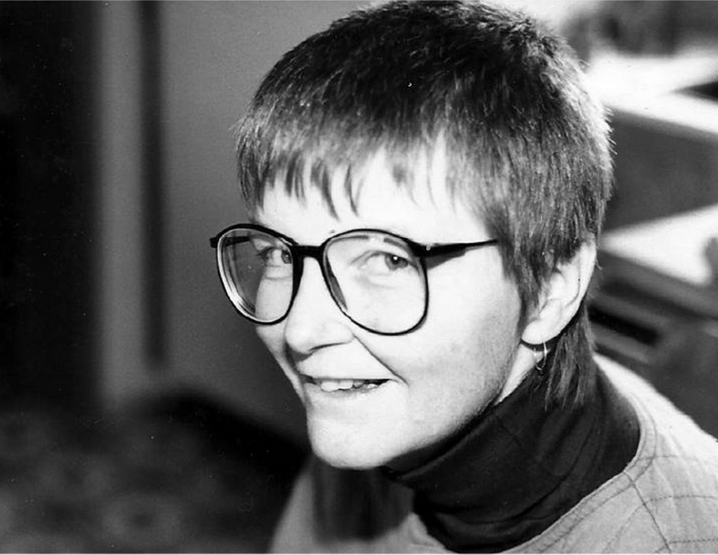
Dresden Arms Motor Hotel, Artillery Place as captioned by https://www.flickr.com/photos/halifaxarchives/33321434210/in/photostream/
Other bars that members of the LGBTQ+ community would frequent at the time included the Seahorse Tavern, which still remains today as a popular bar for LGBTQ+ people of Halifax.
Caotioned as Nancy Brister in the 1980s. (Nancy Brister Collection) in Before the Parade : A History of Halifax's Gay, Lesbian, and Bisexual Communities, 1972-1992 by Rebecca Rose
The Halifax Citadel ($)
Despite the wives being restricted to only 6% of those present, women still made up an important crowd at the Halifax Citadel. Just like soldiers of the time, the wives and children living at the Citadel lived within the barracks of the fort. Additionally, they received rations.
Women at the Citadel took on jobs, often to supplement their husband's military salaries. Jobs for women varied from the grueling task of laundry to the disgusting job of scrubbing down the privies.
Additionally, to learn more about the Citadel, for the cost of Admission, you can enter inside the Fort. The Fort contains a multitude of exhibits, tours, demonstrations, and historical interpreters.
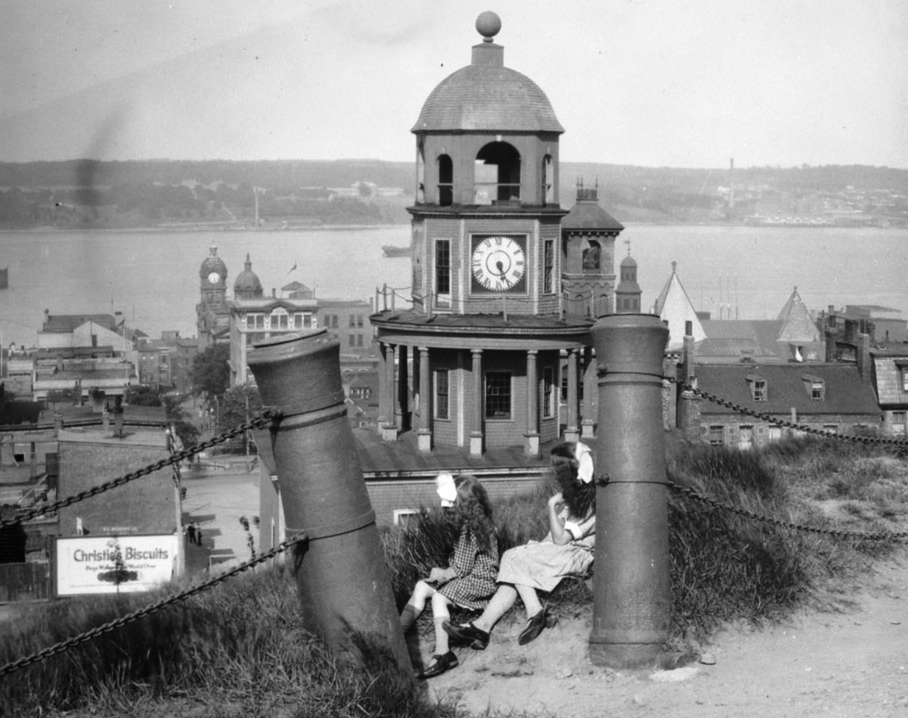
Early 1900s view from the Halifax Citadel. as cpationed by https://www.silverhawkauthor.com/post/artillery-in-canada-9-nova-scotia-fort-george-the-citadel
Cornwallis Street Baptist Church

https://cdn.halifax.ca/sites/default/files/documents/city-hall/boards-committees-commissions/170726hac92pres.pdf
The Cornwallis Street Baptist Church stood and stands today
(now known as the New Horizons Baptist Church) as an important gathering and community space for Black Nova Scotians. In 1956, Althea "Pearleen" Oliver, wife of the pastor at the time, founded the Women’s Institute of the African United Baptist Association (WI-AUBA). It was founded with the African United Baptist Association which, having been established in 1854, made it the oldest Black-established and -controlled institution in the Black African Nova Scotian Community.
It was at the Cornwallis Street Baptist Church that the inaugural meeting was held for the WI-AUBA. 105 women congregated at the Church to discuss their plans. Their hope was to improve health standards, raise educational opportunities, and strengthen family relations in the Black community. The women began holding fundraisers and teaching Sunday school classes to ensure that religion remained prominent within their communities.
Pearleen would continue her legacy within the Civil Rights movement of Nova Scotia. She advocated for the removal of The Little Black Sambo, written by Helen Bannerman (1935) from the education system. Additionally, she wrote her own books such as A Brief History of the Colored Baptists of Nova Scotia, 1782-1953 in order to preserve African Nova Scotian History and replace school textbooks at the time.

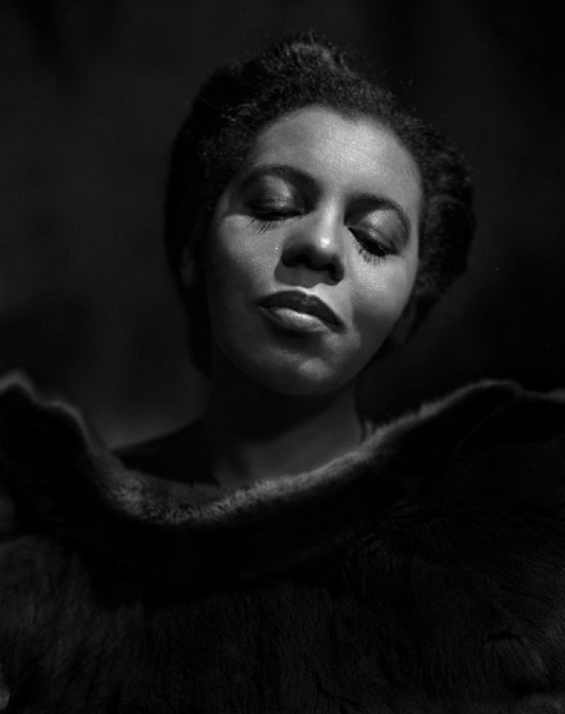
Image of Pearleen Oliver ( https://blackthen.com/dr-pearleen-oliver-co-founder-nova-scotia-association-advancement-colored-people/ )
Pearleen did not stop there. She also helped advocate for increased recreational space in Beechville. Beechville at the time was struggling due to overcrowding and a lack of public services. Pearleen and other families understood the importance of public space for events and the local youth. Their efforts succeeded in establishing the Beechville Centre which remains today as the Lakeside Community Centre.
Portia May White, 1946 © Yousuf Karsh, Library and Archives Canada, PA-192783 as captioned by https://parks.canada.ca/culture/designation/personnage-person/portia-may-white
Fun Fact!
Portia White, the acclaimed singer, also sang at the Cornwallis Baptist Church in the choir as a child. Her father Rev. William White worked as a minister in her youth for the church.
Maud Lewis Exhibit ($)
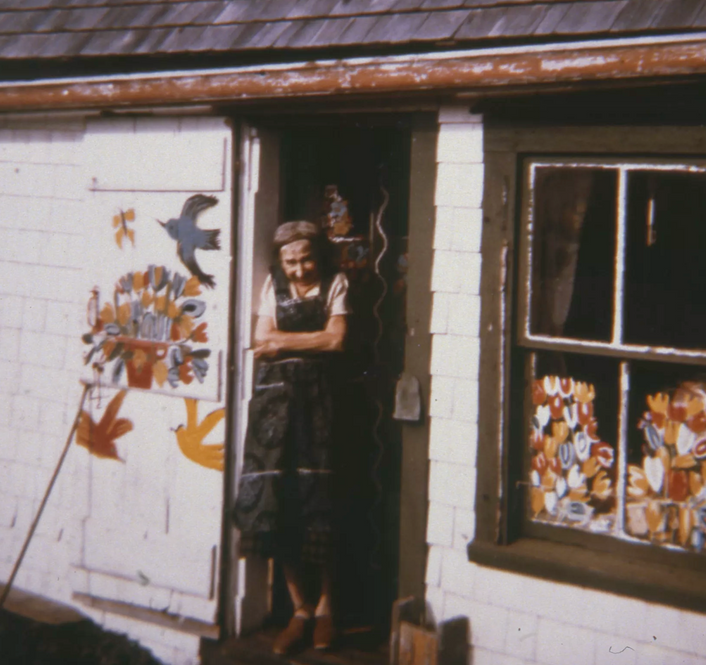
Maud Lewis in front of her house, 1961. Photo by Cora Greenaway. Courtesy of the Art Gallery of Nova Scotia. as captioned by https://www.artsy.net/article/artsy-editorial-joyous-overlooked-canadian-folk-artist-maud-lewis

Maud Lewis, Three black cats, 1955. Courtesy of the Art Gallery of Nova Scotia. as captioned by https://www.artsy.net/article/artsy-editorial-joyous-overlooked-canadian-folk-artist-maud-lewis
Maud Lewis was born in Yarmouth, NS in 1901. Maud started her career as a young child when her mother would sell holiday cards that she had painted.
Maud Lewis would later marry Everett Lewis in 1938 and move into their home in Marshalltown, NS (now on display at the Art Gallery of Nova Scotia). There they spent the rest of their days, with Everett taking care of Maud due to her severe arthritis. She would create paintings and sell them on the side of the road. Additionally, she painted her home which stands as a testament to her creativity.
Maud died in 1970, however, her legacy still continues to grow. Today, many magazines have covered her story, and a documentary was made in her honour.

Maud Lewis, Maud Lewis House. Collection of the Art Gallery of Nova Scotia. Photo by Steve Farmer. Courtesy of the Art Gallery of Nova Scotia. as captioned byhttps://www.artsy.net/article/artsy-editorial-joyous-overlooked-canadian-folk-artist-maud-lewis
To learn more about Maud Lewis's life, you can pay
admission to enter the Art Gallery of Nova Scotia which currently has her work and home on display.
The Statue of
Women Volunteers
In 2017, Halifax unveiled three bronze statues by the waterfront, becoming the first statues in Halifax's history to commemorate the actions of Haligonian Women. The statues, made by artist Marlene Hilton Moore, represent the hundreds of women from Halifax who entertained and serviced the WWII soldiers who found themselves within the city.
The statues represent the many ways women helped the servicemen during the time. A little girl is shown collecting scrap metal. A black woman is shown working in one of the many canteens. And finally, an older woman is shown knitting socks, hats, and scarves with a Mi'kmaq basket.


The monument honouring women volunteers during the Second World War was unveiled Thursday in Halifax. Natasha Pace/ Global News as captioned by https://globalnews.ca/news/3864219/monument-honouring-women-volunteers-during-war-unveiled-in-halifax/
Members of the Halifax North (Women’s) Division of the St. John Ambulance Brigade Association in a practice at their headquarters on West Young Street. Halifax Civil Emergency Corps, September 1942. (Nova Scotia Archives) as captioned by https://www.cbc.ca/news/canada/nova-scotia/halifax-waterfron-women-war-monument-1.3652623
Despite this, the house still remained an important place in the lesbian community where they could go to find other like-minded people and support when needed.
Forrest House

Image of the Laing House which stands presently where the Forrest House had been located (https://fct.ca/blog/laing-house-mental-health-youth-homelessness-fct/)
In 1977, Alexa McDonough and other YM-Women worked to rehabilitate an old Victorian home owned by the YMCA. Their goal was to create a safe space for women. Brenda Bryan, a lesbian, who lived across the street from the previous women's centre understood the importance of community and worked alongside McDonough and the other women to establish the Forrest House, also known as A Women's Place.
A Women's Place stood as an important establishment for women in need. It hosted classes on subjects ranging from one-night stands and sexuality, to self-defense and domestic violence, all the way to car help and math anxiety.
Additionally, the house slowly became a safe haven for women in the LGBTQ+ community. Eventually, a Women's Place had a large lesbian community, which some of the straight feminists felt was damaging to their image of the Forrest House. Feeling the pressure, many lesbian members left which Brenda estimated was about 80% of the Forrest House community. After a few weeks, another straight member reached out inquiring for them to return.
The Local Council of Women
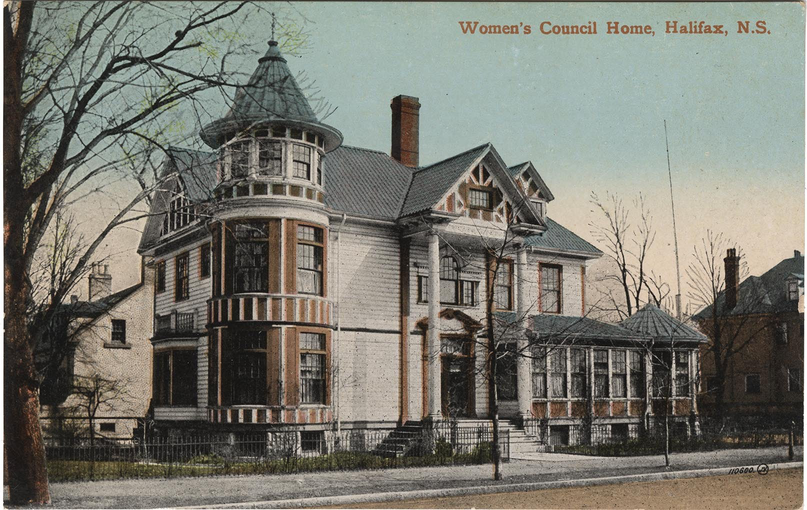
Women’s Council Home, Halifax, N.S.: A picture postcard showing the house as viewed from Young Avenue ~ Source: Photo Collection, Nova Scotia Archives ~ Date: [193-?] as captioned by https://historicnovascotia.ca/items/show/69#&gid=1&pid=1
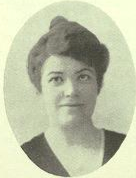
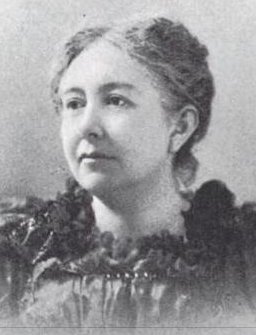
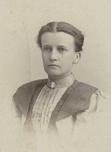
In 1883, Lady Aberdeen, wife of the Governor General, formed the National Council of Women. Soon after she arrived in Halifax and met with prominent feminists of the time who then established the Local Council of Women in Halifax (LCW) in 1984. The George Wright House, which was left to the LCW in his will, has been used for decades by the women to hold meetings and events in hopes of improving women's rights across Nova Scotia. Emma MacKintosh served as their first president.
The early leaders of the women's suffrage in Nova Scotia are today remembered as the Nova Scotia Five; Anna Leonowens, Edith Archibald, Eliza Ritchie, Agnes Dennis, and May Sexton, and are pictured below. In total, they sent 34 petitions to the government attempting to get suffrage for Canadian Women.
On April 26, 1918, were able to get the Nova Scotia Franchise Act with the help of Premier George Henry Murray. The act gave women the right to vote in all provincial elections of Nov Scotia. Only a month later, Prime Minter Robert Borden from NS, (the husband of Laura Bond, past president of the LCW Halifax) passed women's suffrage for the whole country.
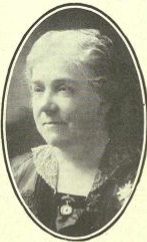
The Nova Scotia Five; May Sexton (Top right), Anne Leonowens (Below Sexton), Edith Archibald (Beside Sexton), Eliza Ritchi (Below Archibald), Agnes Dennis (Beside Ritchi).
Photos from https://lcwhalifax.ca/history/
Killam Memorial Library
In 1955, following the death of her husband, philanthropist Dorothy Killam knew she wanted to commemorate her husband in a big way. Reaching out to Dalhousie University, Dorothy funded the Killam Memorial Library which still stands today in the center of the University.
However, her support did not stop there. She also established academic trusts for Dalhousie and other universities using her nearly 100-million-dollar estate. Dalhousie's Killam Trust makes up 30 million of the estate.
Today, students across the nation still benefit from the kindness of Dorothy Killam and the Killam Memorial Library stands today as a reminder of her generosity.
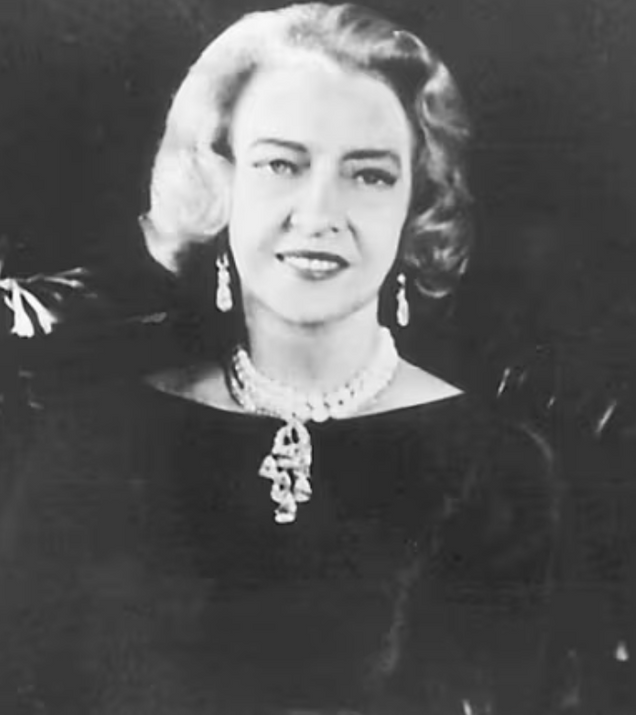

Dorothy J. Killam and Izaak Walton Killam, philanthropists and the founders of the Killam Trusts. (Wikipedia) as cpationed by https://www.cbc.ca/radio/ideas/how-the-killam-family-invented-canadian-culture-1.4954219
Killam Memorial Library - Exterior, n.d. as captioned by https://cdn.dal.ca/content/dam/dalhousie/pdf/library/Library_Administration/Killambuildinghistory.pdf
Quinpool Road Hostel
World War Two was a horrific experience for all Jewish people across the globe. Anti-Semitism was occurring in all regions of the world, and Canada was not any different.
Halifax religious groups rallied across the city to provide support for servicemen while in Halifax and this included Jewish women. Although they contributed in secular manners, Jewish women also worked to create safe and comfortable spaces for the many Jewish Servicemen who arrived in Halifax.
The Quinpool Road Hostel, established in 1942, became a prominent example of this effort. The Hostel worked to provide meals, entertainment, and religious services that followed Jewish dietary laws and culture.

Dance or Recital at Quinpool Road Hostel, Jewish Historical Society (Halifax) fond, Nova Scotia Archives accession no. 1992-329 4 no. 8 as captioned by https://historicnovascotia.ca/files/show/449
Additional Stop:
Mount Saint Vincent University
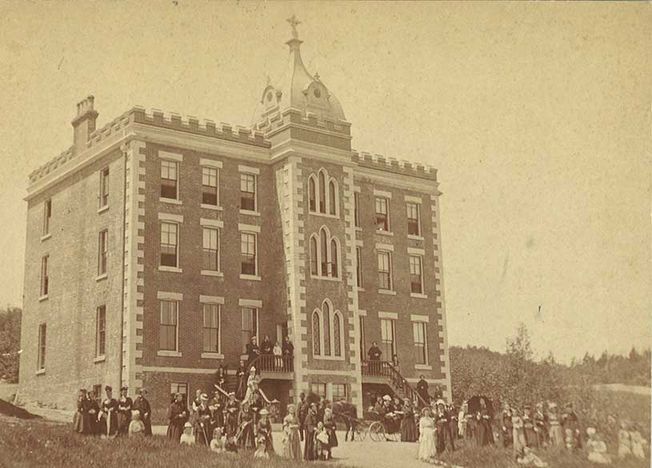
A large swath of land in Rockingham, then outside of the city of Halifax, was purchased for the Sisters’ second Motherhouse and Academy for girls. Over the years, the building would expand to accommodate the increasing number of Sisters, novices, postulants, and Mount Saint Vincent Academy and College students. In January 1951, the building was destroyed by fire as captioned by https://schalifax.ca/beginningofmountsaintvincent/
In 1873, the Sisters of Charity of Saint Vincent de Paul established one of the first few schools where women could access higher education. Although originally intended to train Sisters in becoming teachers, the Sisters of Charity soon realized the necessity of providing education to women across the Province.
In 1912, the Sisters decided to increase their mission of providing education to women by working to establish themselves as a university. Only two years later they made that mission a reality when they partnered with Dalhousie. This allowed Mount Saint Vincent University to offer two years of an undergraduate program to be put towards a bachelor's degree at Dalhousie.
Finally, in 1925, Mount Saint Vicent was granted the right to award degrees of their own by the Nova Scotia Legislature. For the first time in history, the British Commonwealth had an independent all-women university.
References by topic
Viola Desmond:
Mullin, Morgan. “New Viola Desmond Memorial on Gottingen Street Celebrates Her Legacy Perfectly.”
The Coast Halifax. The Coast Halifax, March 24, 2023. https://www.thecoast.ca/arts-music/new-
viola-desmond-memorial-on-gottingen-street-celebrates-her-legacy-perfectly-29782659.
“One Woman's Resistance.” CMHR, January 29, 2018. https://humanrights.ca/story/one-womans-
resistance.
Dr. Maria Louisa Angwin:
“Maria Louisa Angwin, 1849 - 1898.” Nova Scotia Museum, July 5, 2017.
https://museum.novascotia.ca/collections-research/vanguard/gallery/objects/maria-louisa-
angwin-1849-1898?position=28&list=_pCzwO3lUOzlt-487YQGT8ZvLB46F1MIen6hxcljgS0.
Dresden Arms Hotel:
Rose, Rebecca, and Mombourquette, Angela. Before the Parade: A History of Halifax's Gay, Lesbian,
and Bisexual Communities, 1972-1984. Halifax, NS: Nimbus Publishing Limited, 2019, 34-35.
The Halifax Citadel:
Cuthbertson, Brian. “The Halifax Citadel: Portrait of a Military Fortress.” Formac Publishing Company
Limited, 2001. https://viewer.canadacommons.ca/artifacts/2312644/halifax-citadel/3073172
/view/?token=gAAAAABkPV4kImWyj8ZqOnDytsvodYfVyS9QNVpKQEfv9RmSXIr5eG605on8FkO
Op3-TTRKXALpNmCIPOJ--sCVoUv-bAB1k6m55X74pcwaEaAb9AAcS0Px8meBwMndntdUEPn3
TUIjOqJ9AHGjAUqpYMSikJTONIQ==&token=gAAAAABkPV4d4j7MplwwhTyn0-lM6z3AeJDZ9bFj
MCiSGVxrEZSawdUog3zyFj46CYl3xHuhfnlMFjvr7dclcVAePMTG93ZPyT9ck1HJdMe0ORk8fX4qH
hQ%3D&proxy_domain=canadacommons-ca.ezproxy.library.dal.ca.
Cornwallis Street Baptist Church:
Mahon, Danielle. “Mothers of the Civil Rights Movement.” ArcGIS StoryMaps. Esri, May 4, 2021.
https://storymaps.arcgis.com/stories/5d64684e728b4b6d876138029920d387.
the Nova Scotia Museum. “Portia White (1911-1968) - Following a Dream.” Historic Nova Scotia.
Accessed April 15, 2023. https://historicnovascotia.ca/items/show/72?tour=3&index=15.
Maud Lewis Exhibit:
“Maud Lewis.” Art Gallery of Nova Scotia. Accessed April 15, 2023.
https://agns.ca/experience/maud-lewis/.
The Statue of Women Volunteers:
Colley, Sherri Borden. “Halifax's Newest Statue Honours Female War Volunteers | Cbc News.”
CBCnews. CBC/Radio Canada, November 16, 2017. https://www.cbc.ca/news/monument-
women-second-world-war-volunteer-entertainment-1.4403499.
Forrest House:
Rose, Rebecca, and Mombourquette, Angela. Before the Parade: A History of Halifax's Gay, Lesbian,
and Bisexual Communities, 1972-1984. Halifax, NS: Nimbus Publishing Limited, 2019, 88-89.
The Local Council of Women:
“The George Wright House.” The Local Council of Women Halifax, January 22, 2020.
https://lcwhalifax.ca/the-george-wright-house/.
“History.” The Local Council of Women Halifax, July 14, 2022. https://lcwhalifax.ca/history/.
Killam Memorial Library:
“Dalhousie Originals: Izaak & Dorothy Killam.” Dalhousie University. Accessed April 15, 2023.
https://www.dal.ca/about-dal/dalhousie-originals/izaak-dorothy-killam.html.
Quinpool Road Hostel:
MacDonald, Sharon M. H. “Jewish Women Volunteers during WWII.” Historic Nova Scotia. Accessed
April 15, 2023. https://historicnovascotia.ca/items/show/76?tour=3&index=10.
Mount Saint Vincent:
“Tradition and History.” Accessed April 15, 2023. https://www.msvu.ca/about-msvu/university-
profile/tradition-and-history/.
Thank you for joining these women on a journey to learn about their important impacts on Halifax and the world!
For questions or suggestions including locations to add reach out to Emma
em732341@dal.ca
